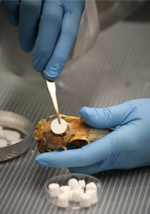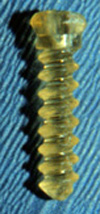
|

|
| Figure 1. Bone regeneration scaffold for use in craniofacial applications |
Figure 2. Resorbable screw for use in fracture repair and reconstructive procedures |
Traumatic bone injury, bone defects and bone disease affect hundreds of thousands of people annually in the US alone. The contemporary standards of care for bone defects and complex fractures include many options for fixation and bone grafting, none of which currently provide an adequate level of success. Effectively treating bone injury requires that osteoconductive materials provide both a mechanical and a biological function. Unfortunately, currently utilized materials have deficiencies, including undesirable changes in shape and strength retention under dynamic loads, release of acidic degradation products causing acute and chronic inflammation, localized acidosis and prevention of osseous healing.
This project explores a compelling alternative: tyrosine-derived polycarbonates, which are exceptionally strong and osteoconductive. These materials can be easily processed, fabricated, and sterilized. Excellent interactions with bone have been demonstrated in multiple animal models. The development of degradable tyrosine-derived polycarbonates for bone regeneration (Figure 1) and fracture fixation (Figure 2) are expected to provide a physiological tissue integrative healing response and enable a significant clinical advancement in bone repair.
Project Leader: Joachim Kohn, PhD
Funding Source: Funding Source: U.S. Army Medical Research and Materiel Command (USAMRMC), the U.S. Army Institute of Surgical Research (USAISR), the Office of Naval Research (ONR), and the National Institutes of Health (NIH). This award is supported by contract number W81XWH-08-2-0034 and W81XWH-14-2-0003 , Armed Forces Institute of Regenerative Medicine I and II.

